Everyone always talks about weather windows, but when we started cruising we were at a loss on how to pick a weather window. What factors were we looking for? Here are a few things we’ve learned, hopefully a starting point for you to figure out your passage tolerence and what weather window you’d prefer for your boat. Clearly my observations are based on our slow but safe full keeled sailboat.

Waiting for Weather Always Takes Longer Than Anticipated. I hear people talk about how they waiting for an ENTIRE WEEK to cross to the Bahamas. But we waited for more than 3 weeks for a window to cross to Isla Mujeres. We’ve been waiting for our current weather window for almost the same period of time – and the window we’d been looking forward to for a week just collapsed.
Everyone says “what are you looking for?”. We want 24 hours ESE – SE 10-15, waves 2-4 with 5+ second intervals, PLUS no thunderstorms or unpredictable fronts in the forecast, and preferably warmer than low 60’s. In addition, we’d like one day ahead of our window for the waves to settle and one day beyond just in case fronts speed up unexpectedly. OK, I know that’s picky, but we’ve been cruising long enough that we prefer having fun on a passage rather than just enduring.
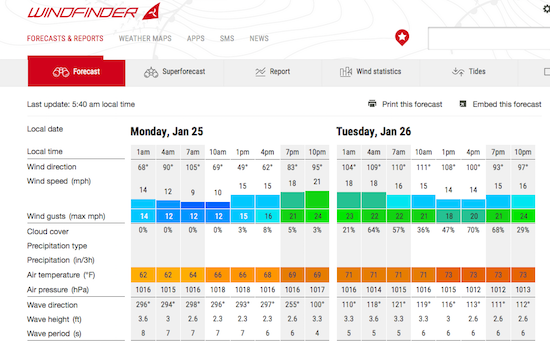
So the weather window we’d been watching was SE 10-15, 2-4 5 sec for 24 hours. Then it got closer it was SE 10-15, 2-4, 5 sec during the day, increasing to SE 10-20, 3-5, 5 sec. Now Chris Parker is warning that the window is OK IF you can be in before sunset. Our experience says if the forecast has a 20 or more in it, the reality is going to be 5 more … i.e. 25, not 20.
Could we go anyway. Sure. Have we in the past? Absolutely. Will we this year? No. Chris Parker is also calling for a major shift in the weather patterns in February – instead of cruisers hiding from weather 5 days a week, he’s predicting it’ll be down to 1-2 days a week. That leaves several days of more settled easterly trades. We can wait.
The key is to be prepared to go at a moment’s notice, but to be comfortable and enjoy life if you have to wait weeks.
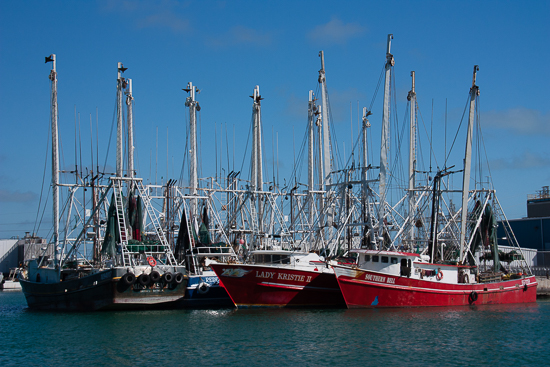
Longer Than You Need. As we all know, weather is never constant, it’s fluid and changes even hour to hour. This means it’s imperative to give yourself longer than you think necessary for your window. For example, we’re watching for a 24 hour sail window, we like at least one day prior and one day after to allow for fronts to speed up or slow down. Better yet would be a longer window, but that’s not likely in the winter.

Let the Waves Settle. This is especially important if you’re looking for a window for crossing the Gulf Stream. Seas in the Gulf Stream get extremely rough when the wind opposes the direction of the current. We were caught in that washing machine once 15 years ago and I have no desire to repeat the experience.
Also keep in mind that whatever the waves forecast is, there’s that little disclaimer that says any individual wave can be 50% higher – so if the forecast is for 2-4, you’ll likely see 3-6 occasionally. If they happen to be coming from on the nose, it can be bumpy even with a 2-4 forecast.
And yet another factor is the wave period. I was clueless about wave periods when we first started cruising – now I know that if the waves are forecast for 2-4 and the wave period is less than the wave height, it’ll still be a choppy bumpy ride. The key is to find a window with the wave period double the wave height. Of course, utopia rarely exists, but we can look & hope!
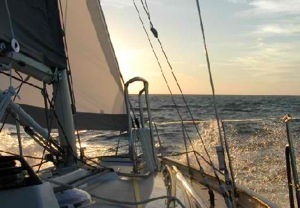
Comfortable Wind Angle. I can’t tell you how many times we’ve waited and waited and taken a marginal window where the wind was forecast to be almost on the nose because we got antsy to go. Of course, almost on the nose, usually turns into directly on the nose or directly astern which can be almost as bad.
Gulf Stream Strategy. When we first crossed the Gulf Stream, headed from the Dry Tortugas to Isla Mujeres Mexico, we had a professional weather routing service and a last minute buddy boat. The buddy boat opted to cross the first Gulf Stream at right angles and sail along the Cuban coast the next morning, while we were bucking the stream following the waypoints at the angle given by our “professional” weather router. Staying in the stream guaranteed we’d stay in the training thunderstorms all night long, while our buddy boat woke to dolphins dancing alongside and sunny skies.
These days we prefer to cut across at a right angle and acknowledge Chris Parker’s assertion that the current will sweep us about 15 miles to the “wrong” side of our destination — or we can aim 15 miles beyond our destination and try to come in about right. The other strategy that works well is to get “downstream” of the current so you’re marginally sailing with it, rather than against 2-3 knots of current. With our boat that’s lucky to sail 5 knots, it’s imperative to take advantage of every angle we can get!
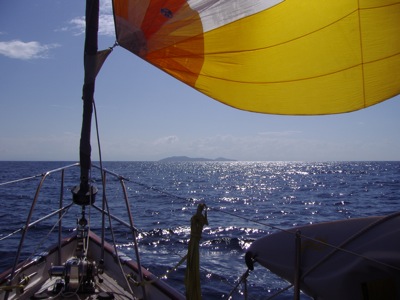
No Wind From Against The Gulf Stream. One more time … this one is important! You’ve likely heard old salt’s advise never to venture out in the Gulf Stream with any wind component from the North. But where the stream crosses the Straits of Florida, it’s more east/west than north/south. The key is no wind component from against the Gulf Stream wherever you’re crossing.
Consider The “Other Side”. It’s easy to get caught up in the weather – winds and waves – at the departure location, but be sure to check if there are any catastrophic effects where you’re sailing to – for example The Whale Cay Passage – and other places in the Bahamas are prone to “rages” when the wind is blowing breaking waves into a narrow pass. San Pedro Belize has the rage issue – one year we couldn’t get out and had to go down behind Caye Caulker to exit the reef. Getting in while surfing big waves in a narrow cut is a recipe for disaster. Some locations close port entrances so you couldn’t surf in even if you were crazy enough to want to try. Better to know the information in advance.
Hopefully this is a good starting point for your boat. Figure out what you enjoy for a passage and don’t let the dock/mooring field pundits persuade you differently. Since we’ve been waiting for awhile and a couple marginal to rough windows have come and gone, we’re getting alot of “exactly WHAT are you waiting for?” We have all winter, we’re not in a hurry. And we prefer to enjoy ourselves, sitting on deck under full sail, sunning ourselves and watching the sparkling water race by. Besides, being “stuck” in Key West is something I used to dream about. 🙂
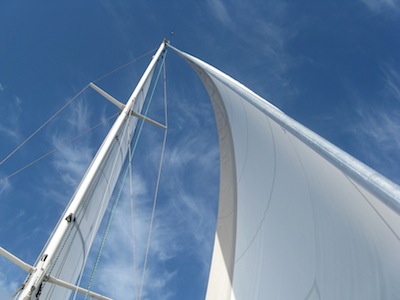
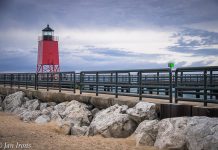












Exactly! We’re doing this for FUN! Would love to be in Key West shorts and flip flops, rather than Michigan with frigid February still to come. All your points about finding a weather window are spot on. Thanks for the guidance on the ‘wave period’ ~ hadn’t heard that one yet. Enjoy!
Hi Peter & Christine! Thanks for reminding me, I AM in shorts & crocs (no flip flops here…), the sun just came out, the 3rd coat of varnish is done and it’s time to go to the beach. 🙂 Cheers! Jan
ha! stuck in Key West…I live in fl. and don’t mind “stuck” at all. double ha.
You’re right Scott! Sometimes my Type A personality gets in my way. Today with the rain might be one of those days…. Cheers! Jan
Great article